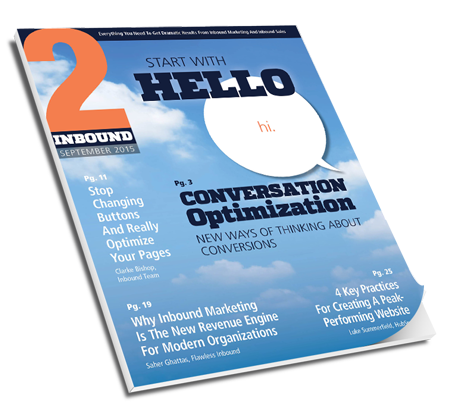Welcome to another edition of “Inbound Marketing Versus…”
The Inbound Out marketing methodology has been up against some fierce competitors, but it has managed to give each of them a run for their money.
In this installment, Inbound Out marketing faces another time-tested technique:
Cold calling.
Everyone’s heard the mantra, “Always be closing!” It comes from cold calling and the way salespeople go through a list of prospects, calling each person to pitch their product or service.
This technique is still used today, but, unfortunately, scammers and telemarketers have given it a bad rap. However, it can still be used effectively in certain industries and under different circumstances.
Here’s how the two compare:
- With multiple people on your team, both Inbound Out marketing and cold calling allow you to contact many prospects at one time. Both are also more personal marketing methods, but Inbound Out lets your prospects receive your marketing when it suits them best.
- Cold calling has a high rejection rate. Inbound Out gives you many points of entry into a person’s life with lower levels of interruption.
- Cold calling is often used by scammers. This has reduced consumer trust in this form of marketing and increased trust in other forms, like social media, email, and doing their own research through useful content.

Let the battle commence!
Inbound Out Marketing Versus Cold Calling — Reach
With multiple salespeople, you can contact many people at one time through cold calling. It’s a more personal form of marketing than many other methods, as you speak directly with your prospects.
If you’re getting a positive ROI, to expand your business you simply need to expand your sales team and scale up.
However, there is one major constriction:
In order to receive your marketing, your prospects need to pick up the phone at the particular moment you’re trying to contact them.
Yes, they can call you back, but people tend to distrust numbers they don’t recognize.
With Inbound Out marketing, you can also contact many people at one time with numerous people on your team, but you’re not constrained by whether your prospects happen to be available to receive your marketing at that time.
You enter their inbox or social media feed and let prospects receive your marketing when it suits them best.
They get back to you on their own time. They don’t feel pressured to respond.
Ironically, this increases response rates and trust in your marketing.
Inbound Out Marketing Versus Cold Calling — Interruption and Rejection
Every form of marketing interrupts a prospect’s life in some way. Even the least salesy form of content marketing still asks prospects to accept an opportunity cost to read and engage with their content.
However, the level of interruption associated with different marketing methods can have drastic effects on the trust you build, your rejection rates, and your business’s image in prospect’s minds.
Cold calling has a high level of interruption. It involves unsolicited calls to people who may only have a marginal interest in your product or service.
You’re also not providing any upfront value. Cold callers are sprinting to the finish line by pushing hard for the sale.
This leads to high rejection rates. Multiple rejections from any one customer can completely cut off that customer from your business, which can have harmful effects on your word-of-mouth exposure.
It can also affect the salesperson’s mentality. Imagine being rejected multiple times a day on most of the calls you make. It can hurt your confidence and zest for the product or service. This erodes their ability to be effective salespeople.
Inbound Out marketing gives you many points of entry into a person’s life, including their social media accounts and email.
The level of interruption is not nearly as high as cold calling. Rejection rates are much lower, because you start the relationship with a lower level of commitment. Your business also provides value first, through free educational content, rather than immediately asking for the sale.
This establishes trust with prospects, while showcasing your business as an authority in their eyes. The content you produce and promote positions you as a teacher.
People trust teachers. They tend to distrust salespeople.
Inbound Out Marketing Versus Cold Calling — Trust and Outreach
If executed the right way, personal outreach is powerful. It establishes connections on a personal level that most prospects aren’t used to from businesses.
And they appreciated it. That’s what makes it effective.
Unfortunately, cold calling does not handle one-on-one outreach effectively. It’s often used by scammers, who have tarnished it in consumers’ eyes (like the Microsoft support scams).
As consumers have gained more power through information available on the Internet, they’re better at identifying scammers who are cold calling. This means they’re more aware of how many scammers use this technique, and they tend to associate the technique with people attempting to swindle them.
On the other hand, reaching out through social media and email is natural. Inbound Out marketing is powerful because it’s personal outreach that’s executed unobtrusively.
You’re not mass messaging people, but rather entering their lives on a one-on-one basis in ways that let them choose whether or not to listen to you.
That freedom of choice is what prospects want. Inbound Out marketing gives it to them.
Traditional marketing no longer works well because buyers have changed. You must learn to adapt. Download the CEO's 2016 Guide to Marketing now and learn to execute your own 2016 marketing strategy today.
Takeaways
- Both cold calling and Inbound Out marketing allow you to contact many people at one time. But Inbound Out lets your prospects receive your marketing when it suits them best—on their own terms.
- Cold calling involves a high level of interruption into prospects’ lives, which leads to a high rejection rate. Inbound Out marketing gives you many points of entry into a person’s life. Rejection rates are much lower because your business provides value first.
- Cold calling does not handle one-on-one outreach effectively, as it’s often used by scammers. Inbound Out marketing focuses on social media and email, two channels where people accept marketing more naturally.









